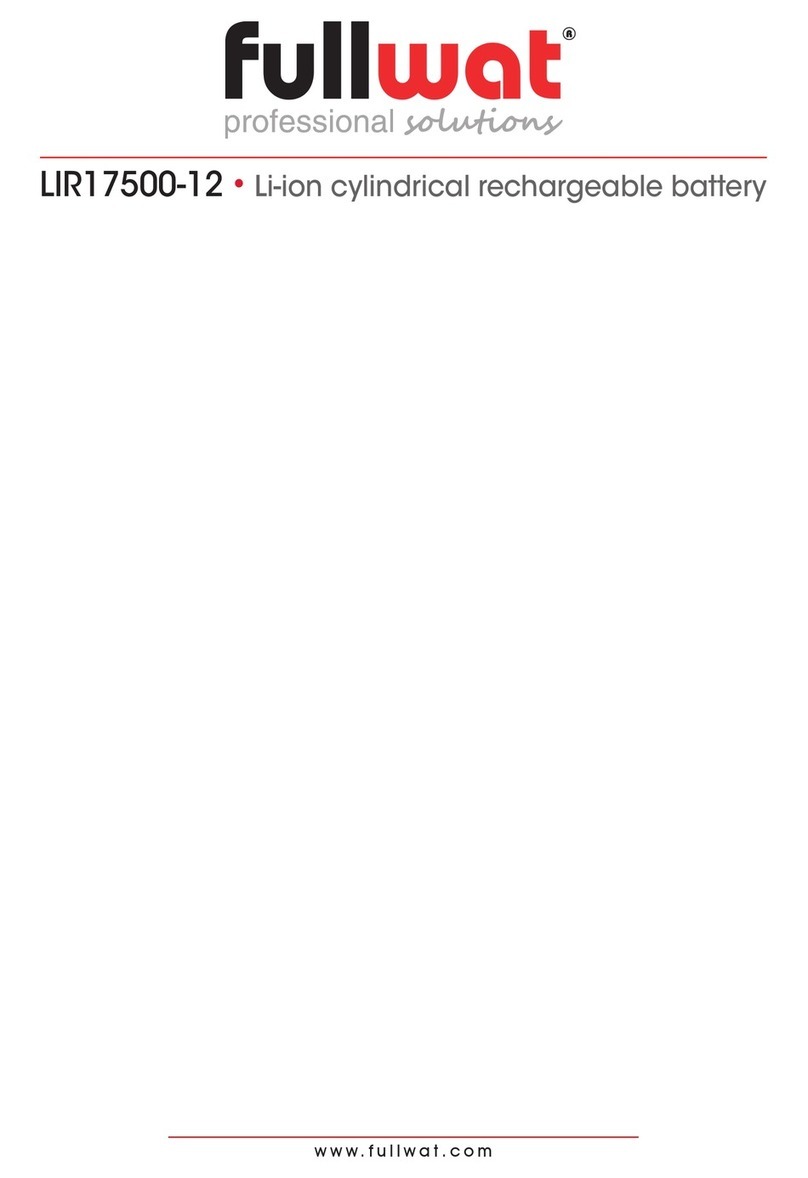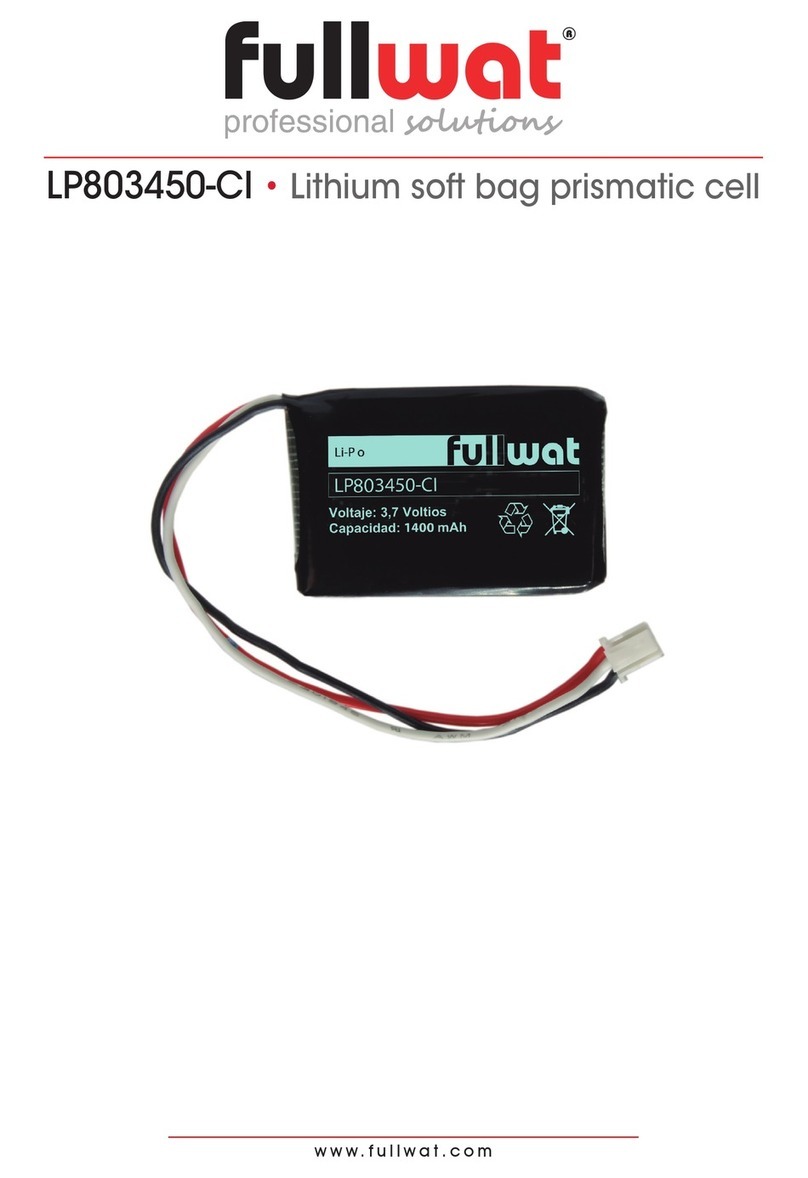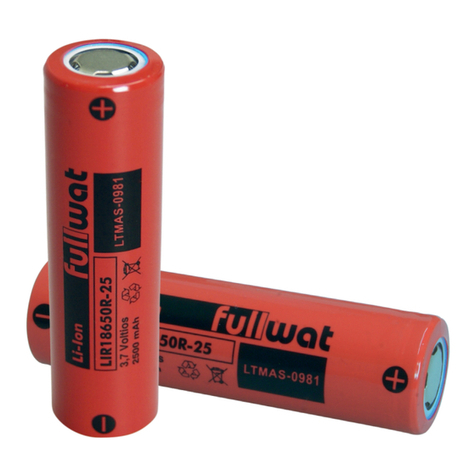
www.fullwat.com
LIR18650-34 •Li-ion cylindrical rechargeable battery
2.Safetyinstructions
Batteries containing organic solvents and other ammable substances, such as improper use may cause the core
heat or re, resulting in damage to the battery or personal injury. Please pay attention to the use of prohibited items,
while the protection device should be added to avoid the use of equipment caused by abnormal batteries accident.
Before using lithium-ion rechargeable batteries, please read the following safety guidelines carefully. In addition,
God strongly recommends adding these instructions to the user manual.
2.1Dangerousmatter
2.1.1 Don’t use or place batteries in high temperature (above 55ºC) environment. Do not put it into re, water
or make it moisture. Do not repair or disassemble batteries, there is a risk of causing the batteries to
ignite, overheat, leak or explode.
2.1.2 Don’t place the batteries in a chaotic manner, away from metal and other conductive materials to avoid
positive (+) negative (-) short circuit, do not reverse the positive (+) negative (-) pole
2.1.3 Don’t use non-specied charging equipment and violate charging requirements. Non-specied conditions
charge will cause the battery to overcharge or abnormal chemical reactions, heat generation, smoke,
rupture or re.
2.1.4 Don’t connect the battery to the AC plug (outlet) or the car plug. The battery needs to have a specic
charger. If the battery is connected directly to the plug, the battery may catch re, smoke, explode, or
cause heat.
2.1.5 Don’t overcharge, over-discharge, drive nail into the cell, strike it by hammer or tread and step on it 2.1.6
Don’t hit or throw batteries. If the batteries appear to fall, please treat the waste, can not continue to use.
2.1.7 Don’t dissect the battery. If the protection line is damaged, the battery will no longer be protected. Then,
the battery may re, smoke, explode or cause heat.
2.1.8 Don’t charge near high temperatures. If the battery is charged near the high temperature, the battery
can not be recharged due to the protection line. In this case, the protection circuit may be interrupted,
the battery may re, smoke, explode or cause heat.
2.1.9 Don’t use batteries that are clearly damaged or deformed. May cause fever, smoke, rupture or burning.
2.1.10 Don’t direct soldering of batteries, overheating will lead to insulation gaskets and other parts of the
deformation, causing cell deformation, leakage, explosion or re.
2.1.11 Don’t reverse polarity charge. In the case of charging, the battery is reverse charging will be abnormal
chemical reaction. In addition, there is an unpredictable high current through the discharge. These may
cause heat, smoke, rupture or burning.
2.2Warning!
2.2.1 Batteries should be kept away from infants and young children. In case of swallowing the battery, please
seek medical attention immediately.
2.2.2 Don’t place the battery in a microwave oven or other cooking utensils. Due to the heating and electrical
shock of the microwave oven, the battery may ignite, smoke, explode or cause heat.
2.2.3 Don’t mix with other batteries. The battery can not be mixed with other different capacities, chemical
systems, or manufacturers’ batteries. Do not connect other batteries or mix other batteries. The battery
may catch re, smoke, explode or cause heat.
2.2.4 Don’t use an abnormal battery. If there are obvious abnormalities, such as odor, fever, deformity or
discoloration, stop using the battery. Such batteries may be defective and, if used, may cause re,
smoke, heat or explosion.
2.2.5
If the charging process does not end, stop charging. If the battery can not complete the charging process for
a specied period of time, stop the charging step. The battery may catch re, smoke, explode or cause heat.
2.2.6 Don’t use a leaky battery near a ame. If the battery or liquid out of the battery produces a pungent odor,
the battery should remain away from the ame. The battery may be ignited or exploded.

































